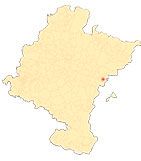Javier, a castle for a saint
Coats of arms of the lineages on the gate of entrance
The main gate of the castle is the third one that must be crossed to enter the building. It is located in the eastern section, which was rebuilt, like the neighbouring tower of Undués, in the 15th century. In the first restoration, its cladding was unified to achieve a fairly uniform ashlar façade. Defended in height by a large machicolation, inserted in a line of battlements and supported by four modillions, the gateway responds to the aesthetic criteria prevailing in the last third of the 15th century. It is three metres high and consists of an ogival arch with a large architrave, made up of thirteen ashlars. A lateral arrow slit, in the neighbouring southern polygon, protects the door.
It is crowned by a rectangular sandstone bas-relief that houses the coats of arms of the castle and of the two lineages that restored it in the second half of the 15th century and early 16th century. In the centre is the original coat of arms of Javier, belonging to the Aznárez de Sada family, owners of the castle since 1237. On a field of gules, a crescent crescent turned silver with a checkered border of two strips of gold and sable (black), placed on a checkered band of three strips of gold and sable, seated on a silver field (ground).
On both sides of the central coat of arms, two angels with outstretched wings proclaim the excellence of the lineage of Javier and give way to the side coats of arms in which, without losing their privileged position, they insert and receive the two lineages that renew it. On the left (viewer's right) the arms of Javier alternate in a quarter with those contributed by Martín de Azpilcueta, who as a nobleman from Baztanes used silver and sable (black) checkering and as the husband of Juana Aznárez de Sada from 1463 began the reconstruction of the castle. On the right (viewer's left), the coat of arms of Javier alternates in quarters with those of Juan de Jaso, lord of Javier by his marriage to María de Azpilcueta (1484), who completed the reconstruction and modernisation of the castle over two decades: on a silver field, a sinople tree (green) with a wild boar sprouting (superimposed). The combination of the coat of arms of Javier with those of Jaso and Azpilicueta was symbolic. Javier was reborn from its ashes thanks to the efforts of two families whose coats of arms left a reminder of this on the castle walls, although recognising the superior rank of the original coat of arms, destined to integrate them. The same will happen with the surnames of their descendants. Both the heir to the castle -Miguel- and the saint -Francisco-, will end up being "de Javier", relegating the paternal surname .












